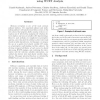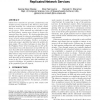180 search results - page 28 / 36 » Locating causes of program failures |
WCET
2007
13 years 8 months ago
2007
Memory corruption is one of the most common software failures. For sequential software and multitasking software with synchronized data accesses, it has been shown that program fa...
CONEXT
2010
ACM
13 years 5 months ago
2010
ACM
Client-server networks are pervasive, fundamental, and include such key networks as the Internet, power grids, and road networks. In a client-server network, clients obtain a serv...
EUROSYS
2010
ACM
14 years 4 months ago
2010
ACM
Debugging real systems is hard, requires deep knowledge of the code, and is time-consuming. Bug reports rarely provide sufficient information, thus forcing developers to turn int...
CSFW
2011
IEEE
12 years 7 months ago
2011
IEEE
—Randomization is used in computer security as a tool to introduce unpredictability into the software infrastructure. In this paper, we study the use of randomization to achieve ...
SIGSOFT
2008
ACM
14 years 8 months ago
2008
ACM
NesC is a programming language for applications that run on top of networked sensor nodes. Such an application mainly uses an interrupt to trigger a sequence of operations, known ...


